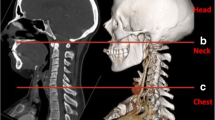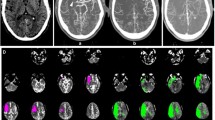Abstract
Background
Recently published clinical trials have resulted in a significant change in the guidelines used to manage patients suffering an acute ischaemic stroke. New neuro-interventional techniques have revolutionised stroke outcomes. Currently, such services are only available in two specialist centres.
Aims
We attempted to evaluate the need for the provision of routine computed tomography (CT) angiography and neuro-interventional services at a university teaching hospital in Limerick.
Methods
A retrospective study was performed based on data collated by the stroke service, University Hospital Limerick (UHL). All patients with a suspected acute ischaemic stroke of anterior circulation and known evolution were included. Baseline clinical and imaging characteristics, thrombolysis data, stroke unit admission rates and discharge destinations were recorded.
Results
All 141 patients were suitable for CT angiography and should be performed in accordance with guidelines. Additionally, 165 patients excluded from the study due to an unknown stroke evolution timeframe may have benefitted. Non-contrast CT scan confirmed just 12 anterior circulation strokes. The need for neuro-interventional services proved more difficult to assess, primarily due to the lack of provision of routine CT angiography, employed to confirm anterior circulation occlusion. Secondary results showed a thrombolysis rate of 10.8% and confirmed that time efficiencies result in higher thrombolysis eligibility rates. Stroke unit admissions and discharge destinations were also recorded.
Conclusion
UHL should provide routine CT angiography to all patients presenting with acute ischaemic stroke in line with current guidelines. The need for provision of neuro-interventional services on-site proved more difficult to assess and requires further analysis.


Similar content being viewed by others
Notes
Endovascular treatment for small core and anterior circulation proximal occlusion with emphasis on minimising CT to recanalization times.
Scores on National Institutes of Health Stroke Scale (NIHSS) range from 0 to 42, with higher scores indicating more severe neurological deficits. It is an important score. Thrombolysis is indicated in UHL if NIHSS score is in the range 4–24, above which the risk may outweigh any benefit. Additionally, thrombectomy may be indicated in scores of ≥ 5.
Alberta Stroke Programme Early Computed Tomography Score (ASPECTS) is an imaging measure of the extent of the ischaemic stroke. Score range from 0 to 10, with higher scores indicating a smaller infarct core.
The modified Rankin scale (mRS) is a commonly used scale for measuring the degree of disability or dependence in the daily activities of people who have suffered a stroke or other causes of neurological disability. It has become the most widely used clinical outcome measure for stroke clinical trials. The scale runs from 0 to 6, running from perfect health without symptoms to death.
0—No symptoms.
1—No significant disability. Able to carry out all usual activities, despite some symptoms.
2—Slight disability. Able to look after own affairs without assistance, but unable to carry out all previous activities.
3—Moderate disability. Requires some help, but able to walk unassisted.
4—Moderately severe disability. Unable to attend to own bodily needs without assistance, and unable to walk unassisted.
5—Severe disability. Requires constant nursing care and attention, bedridden, incontinent.
6—Dead.
References
World Health Organisation (2014) The Top 10 Causes of Death Available: http://www.who.int/mediacentre/factsheets/fs310/en/
Feigin VL, Forouzanfar MH, Krishnamurthi R et al (2014) Global and regional burden of stroke during 1990–2010: findings from the global burden of disease study 2010. Lancet 383:245–255
Donnan GA, Fisher M, Macleod M et al (2008) Stroke. Lancet 371:1612–1623
Wunderlich MT, Goertler M, Postert T et al (2007) Recanalization after intravenous thrombolysis does a recanalization time window exist? Neurology 68:1364–1368
Lees KR, Bluhmki E, von Kummer R et al (2010) Time to treatment with intravenous alteplase and outcome in stroke: an updated pooled analysis of ECASS, ATLANTIS, NINDS, and EPITHET trials. Lancet 375:1695
Prabhakaran S, Ruff I, Bernstein RA (2015) Acute stroke intervention: a systematic review. JAMA 313:1451–1462
Lee KY, Han SW, Kim SH et al (2007) Early recanalization after intravenous administration of recombinant tissue plasminogen activator as assessed by pre- and post-thrombolytic angiography in acute ischemic stroke patients. Stroke 38:192–193
Trialists’ Collaboration, Stroke Unit (2007). Organised inpatient (stroke unit) care for stroke. Cochrane Database Syst Rev, 4(4)
Berkhemer OA, Fransen PS, Beumer D et al (2015) A randomized trial of intra-arterial treatment for acute ischemic stroke. N Engl J Med 372(1):11–20
Goyal M, Demchuk AM, Menon BK et al (2015) Randomized assessment of rapid endovascular treatment of ischemic stroke. N Engl J Med 372:1019–1030
Irish Heart Foundation (2015). Stroke thrombolysis guidelines version 2.0. Updated: March 2015
Latchaw RE, Alberts MJ, Lev MH et al (2009) Recommendations for imaging of acute ischemic stroke: a scientific statement from the American Heart Association. Stroke 40:3646–3678
Menon BK, Demchuk AM (2011) Computed tomography angiography in the assessment of patients with stroke/TIA. The Neurohospitalist 1:187–199
Menon BK, d’Esterre CD, Qazi EM, Almekhlafi M, Hahn L, Demchuk AM, Goyal M (2015) Multiphase CT angiography: a new tool for the imaging triage of patients with acute ischemic stroke. Radiology 275(2):510–520
Horgan, F, Hickey, A, McGee, H et al. (2008). Irish heart foundation national audit of stroke care. Irish Heart Foundation. Dublin
Kelly P, Harbison J (2012) Stroke clinical care Programme: model of care. Health Service Executive Quality and Clinical Care Directorate, Dublin
Summers D, Leonard A, Wentworth D et al (2009) Comprehensive overview of nursing and interdisciplinary care of the acute ischemic stroke patient a scientific statement from the American Heart Association. Stroke 40:2911–2944
Author information
Authors and Affiliations
Corresponding author
Ethics declarations
Funding
There was no funding for this research.
Conflict of interest
The authors declare that they have no conflict of interest.
Ethical approval
This article does not contain any studies with human participants performed by any of the authors.
Rights and permissions
About this article
Cite this article
Halpin, J., Peters, C., O’Brien, J. et al. In light of recently published clinical trials and their implication for clinical practice, does a large catchment area acute hospital require 24 hour CT neck and head angiography and/or neuro-interventional services in the setting of acute ischaemic stroke?. Ir J Med Sci 187, 351–358 (2018). https://doi.org/10.1007/s11845-017-1674-0
Received:
Accepted:
Published:
Issue Date:
DOI: https://doi.org/10.1007/s11845-017-1674-0




